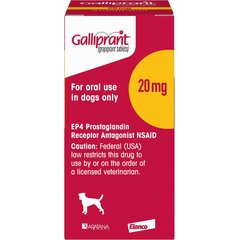Galliprant® (grapiprant) for Dogs
iStock/Brothers91
PetMD’s medications content was written and reviewed by veterinary professionals to answer your most common questions about how medications function, their side effects, and what species they are prescribed for. This content shouldn’t take the place of advice by your vet.
What Is Galliprant® for Dogs?
Galliprant® (active ingredient grapiprant) for dogs is a prescription veterinary nonsteroidal anti-inflammatory drug (NSAID) used in the management of pain and inflammation associated with osteoarthritis in dogs.
In dogs with osteoarthritis, cartilage wears down on the surface of the joint, which causes the bones and nerve endings of the joint to painfully rub together.
If your veterinarian suspects osteoarthritis in your dog, they may prescribe Galliprant® to help your dog feel more comfortable and improve mobility.
Galliprant® does not cure osteoarthritis but helps improve symptoms such as trouble rising from rest, slowing down on walks, limping, and trouble jumping onto furniture, navigating steps, or getting up into the car.
Galliprant® Considerations in Dogs
Galliprant® should not be used in dogs who are hypersensitive to the active ingredient, grapiprant. At the time of this publication, safe use had not yet been established in dogs younger than nine months of age, dogs weighing less than eight pounds, breeding, pregnant, or lactating dogs, or in dogs with heart disease.
Galliprant® should be used with caution in dogs with the MDR1 gene mutation (common in Collies, Shelties, and Australian Shepherds).
Dogs with this gene mutation (also known as ABCB1-1delta) have a harder time breaking down certain types of medications including Galliprant®. If your dog has this gene mutation, your vet may decrease your dog’s dosage accordingly.
Giving Galliprant® with certain medications can result in health risks to your dog, so it is important to discuss your pet’s medications, including vitamins and supplements, and medical conditions with your veterinarian.
How Galliprant® Works in Dogs
The active ingredient in Galliprant®, grapiprant, is a newer NSAID with a unique mode of action that blocks inflammation and pain through a different pathway than other commonly prescribed NSAIDs.
As Galliprant® specifically blocks a certain receptor (prostaglandin EP4) whereas traditional NSAIDs block COX (cyclooxygenase), Galliprant® helps provide relief from pain and inflammation with less potential impact on the gastrointestinal system, blood vessels, and the normal formation of blood clots.
Galliprant® Directions for Dogs
Check instructions on the label and from your veterinarian.
Galliprant® is usually given once a day. The lowest effective dose is recommended to be given over the shortest period of time and is dependent on your pet’s response to the medication.
Galliprant® may be given with or without food. Your vet will recommend what is best for your dog.
Missed a Dose?
Speak with your veterinarian about what to do if you forget to give a dose of Galliprant®. Generally, they may instruct you to give it when you remember, or if it is almost time for your pet’s next dose, to skip the missed dose and resume your normal dosing schedule. Do not give extra or double doses.
Possible Side Effects of Galliprant® in Dogs
Possible side effects of Galliprant® in dogs may include:
- Vomiting and diarrhea
- Lack of appetite
- Lethargy
- Soft stool with mucus
- Watery or bloody stools
Human Side Effects
This medication is not approved for use in humans. Due to possible side effects, humans should never use medicine dispensed for their pets and pets should not be given any medicine dispensed for a human’s use.
If you accidentally ingest a pet medication, call your physician or the national Poison Control Center hotline at 800-222-1222.
Monitoring
Your veterinarian may recommend a complete blood count and blood chemistry panel periodically while on this medication, especially with long-term use. Your veterinarian may also recommend additional routine testing depending on your pet’s individual needs and other medications they may be on.
Call Your Vet If
-
Severe side effects are seen (see above)
-
Your pet’s condition worsens or does not improve with treatment
-
You see or suspect an overdose
-
You have additional questions or concerns about the use of Galliprant®
Galliprant® Overdose Information in Dogs
The most common signs of overdose of Galliprant® are vomiting, loss of appetite, and changes in stool (diarrhea, soft stool, or mucus stool). Decreased blood protein levels and elevated liver related enzymes may be observed, especially with chronic overdose.
If you suspect an overdose, immediately contact your veterinarian or an animal poison control center. Consultation fees often apply.
Pet Poison Helpline (855) 764-7661
ASPCA Animal Poison Control (888) 426-4435
Galliprant® Storage in Dogs
Galliprant® should be stored at controlled room temperatures at or below 86 F. Keep the container tightly closed to protect from moisture and light. Always confirm storage requirements by reviewing the label.
Keep out of reach of children and pets.
Galliprant® FAQs
How long can a dog stay on Galliprant®?
Osteoarthritis is a chronic disease, so Galliprant® may need to be given for extended periods of time. Galliprant® should be used at the lowest dose that provides adequate pain relief. It is best to speak with your veterinarian about long-term management of osteoarthritis.
How long does it take for Galliprant® to work for a dog?
A noticeable improvement in your pet’s pain and inflammation is usually observed in the first few days to a week, and sometimes even up to a month after starting Galliprant®. Once the pain and inflammation has subsided, your veterinarian may recommend continuous long-term use of Galliprant® to help maintain your pet’s pain relief.
Does Galliprant® make a dog sleepy?
Galliprant® does not typically make dogs sleepy, but they may experience more tiredness and seem less energetic than usual. If you notice your pet sleeping a lot more while taking this medication, please let your veterinarian know right away.
No vet writer or qualified reviewer has received any compensation from the manufacturer of the medication as part of creating this article. All content contained in this article is sourced from public sources or the manufacturer.

